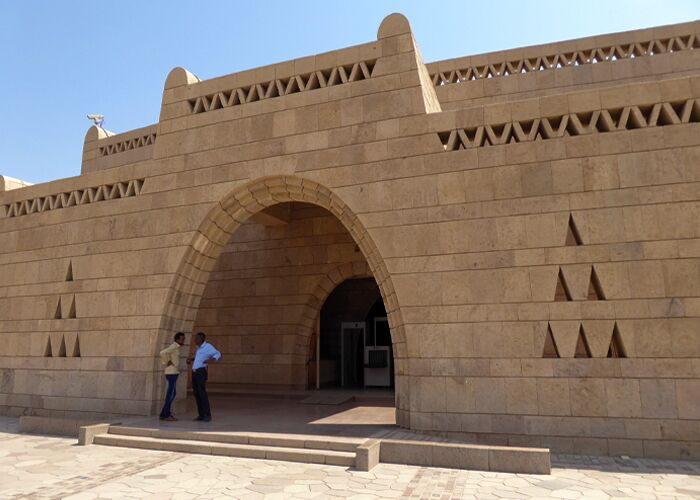The Nubian Museum in Aswan is an absolute must-see.
The building of the Museum is now progress.
Nubian Museum’s façade is surrounded by an extensive garden, which has a wide range of Egyptian plant species and a diversity of plant varieties.
It has three floors on the inside, which are accessible via stairs.
The first floor, which is below ground and can only be accessed by elevator, houses the building’s workshops and repair laboratories.
Monuments and other relics abound on the second floor, which is somewhat larger than the first level.
Finally, the third floor has a library, a cafe, staff offices, and storage rooms for photographs and microfilm.
Examples of subjects discussed are how to get there best.
The Aswan Nubian Museum’s historical context.
The building of a museum
Interior of the museum as well as its importance.
Nubian Museum in Aswan, Egypt, is one of the world’s most popular tourist sites and one of the best museums in the world; it is situated in Aswan.
17 sections are displayed in this museum, which cover everything from prehistoric times to present-day times. They include sections on the Nubian region, the environment of Nubia, the origins of Egypt’s Nile Valley, the Neolithic civilizations, the Pyramid Age, the Medieval Nubian Kingdom of Kush, Egypt’s Egyptian civilization in Nubia, and the Kingdom of Meroe. Over 3000 works of art may be found in this museum.
What’s the best route to take?
People may easily travel to the Nubian museum by taxi or car.
In the immediate vicinity of the museum, there are several restaurants and lodgings.
The museum is open from 9 a.m. to 1 p.m. and 4 p.m. to 9 p.m., Monday through Friday.
– The evolution of the Aswan Nubian Museum
Designed by Egyptian architect Mahmoud El-Hakim and featuring installations by Mexican designer Pedro Ramirez Varquez, this museum was awarded the Agha Khan Prize in 2001 as one of the world’s most beautiful architectural buildings as one of the world’s most beautiful museums.
It took Egypt 75 million Egyptian pounds to build this museum.
The museum was built as part of the UNESCO effort to safeguard the Nubian monuments from the high dam building, with plans to build it commencing in the 1980s. The museum was constructed.
– The museum’s construction is underway.
The Nubian museum has a wide range of artefacts, but one of its most popular displays is a skeleton of an adult human being that was unearthed near Aswan, Egypt, in 1982 and dates back to 20 thousand years.
More than 500 artefacts from Aswan and Nubia’s history are housed in the museum, including around 103 Islamic artefacts, 503 Ancient Egyptian artefacts, 52 Coptic artefacts, and over 500 whose origin is unknown.
Each work of art has a card in front of it that identifies it in Arabic and English, so that the visitor may learn more about it.
There are no other museums like the Nubian Museum, where you will find a unique collection of antique artefacts from the past.
A wide variety of objects will be on show at the auction including jewellery and crowns made of precious stones as well as household appliances, musical instruments, and clothing.
Throughout history, the Nubian people have made use of all of the items mentioned above, as well as a slew of others.
A few of the strangest objects, such as figures, show the daily lives of the Nubians, including the clothes they wear, their professions, and the techniques they use to manufacture their handicrafts.
Outside the Nubian Museum building, visitors may walk around the garden that surrounds it and learn more about its history and artefacts.
While you’re there, take in the magnificent Egyptian Flora and the fresh air. Also on exhibit at the museum are more than eighty ancient sculptures and historical pebbles.
A cave adorned with prehistoric artefacts may be seen there, as well as several artificial lakes created to resemble the Nile River.
Several Nubian performances, in which the Nubian people themselves perform for museum visitors to exhibit their traditions and culture, are also presented here on a regular basis.
– The inside of the museum
An adult human skeleton that dates back about 20.000 years that was discovered in Aswan, Egypt, back in 1982 is one of the museum’s most well-known exhibits. The museum has monuments from diverse eras on display.
More than 500 artefacts from Aswan and Nubia’s history are housed in the museum, including around 103 Islamic artefacts, 503 Ancient Egyptian artefacts, 52 Coptic artefacts, and over 500 whose origin is unknown.
Each work of art has a card in front of it that identifies it in Arabic and English, so that the visitor may learn more about it.
There are no other museums like the Nubian Museum, where you will find a unique collection of antique artefacts from the past.
There will be a wide variety of products on exhibit, from fine jewellery and crowns to domestic utensils and pottery bowls, all of which are sure to catch your eye.
Throughout history, the Nubian people have made use of all of the items mentioned above, as well as a slew of others.
A few of the strangest objects, such as figures, show the daily lives of the Nubians, including the clothes they wear, their professions, and the techniques they use to manufacture their handicrafts.
Outside the Nubian Museum building, visitors may walk around the garden that surrounds it and learn more about its history and artefacts.
While you’re there, take in the magnificent Egyptian Flora and the fresh air.
Also on exhibit at the museum are more than eighty ancient sculptures and historical pebbles.
A cave adorned with prehistoric artefacts may be seen there, as well as several artificial lakes created to resemble the Nile River.
Several Nubian performances, in which the Nubian people themselves perform for museum visitors to exhibit their traditions and culture, are also presented here on a regular basis.

